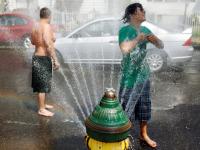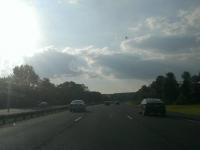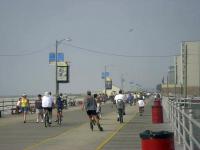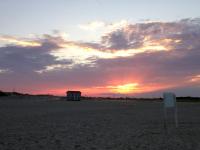Daily temperatures naturally fluctuate from week-to week and year-to-year (factoring out the seasonal “march” of temperature). Thus when temperature trends emerge over decades, it sparks a special interest here in the Office of the New Jersey State Climatologist. We are in the midst of a project to examine prolonged heat episodes throughout the state and have found some evidence for recent increases in such events. As impressive winter cold slowly comes to an end in NJ is there a better time to present some of our heat results? Of course not!
Our study involves examining daily maximum and minimum temperatures for seven stations distributed across the state, each with 100-plus years of records. This study began last summer with an evaluation of New Brunswick heat events. We showed that New Brunswick has had an increase of daytime heat events in recent decades and nighttime heat events are becoming more commonplace. In the course of expanding our analysis to seven stations, we have found larger changes in warm nighttime temperatures than in hot daytime temperatures. Excessively warm nighttime temperatures typically get overlooked when discussing potentially dangerous heat episodes, yet they can bring about dangerous health concerns for those unable to escape persistent warmth.
We looked broadly at data from the seven stations for May through September. All of these stations moved at least once throughout the many decades of their existence and instrumentation has changed. However, neither should be a major issue, particularly instrument changes. Also, we chose stations with a minimal number of moves, therefore limiting potential impacts of changes in elevation and the surrounding landscape on temperature trends. Furthermore, changes in location do not influence anomalously warm minimum temperatures nearly as much as, for instance, anomalous cold values, given the absence of thermal inversions on milder-than-average nights (these inversions lead to temperatures that are highly topographically dependent on cold nights). The only station where landscape change has greatly impacted local temperatures is Newark Airport. Urbanization there has warmed temperatures considerably since the 1930s. However, a major point of this exercise is to examine and heighten awareness of potentially dangerous nighttime warmth, not solely to look at regional changes, so it is appropriate to include Newark amongst the stations examined.
In order to compare the stations, we need to look at the difference between the frequencies of heat events under a statistical lens. Without this analysis, we would be unable to determine if trends in heat events are applicable only to individual stations, or rather to the state of New Jersey as a whole. ANOVA (analysis of variance, used in order to examine the differences between multiple groups of data) is the best statistical method for this evaluation and was used to compare all of the stations to each other while minimizing the amount of statistical error that would arise from individual comparisons of station pairs. This analysis generally confirmed that heat event changes varied by region, thus we are confident that heat event occurrences and trends are strongly influenced by local climate features (e.g., topography, urban vs. rural, coastal vs. continental). The ANOVA method and our other statistical metrics are valid at a significance level of 5%.
Similar to our New Brunswick study, we extracted days that fell within the top 10% of observations for each individual day for nighttime warmth during the past from May–September. We also did this for days within the top 5% and 1%. Next, we looked for runs of days each year falling within each category. Runs of three or more nights and five or more nights were generated. Our seven stations included: Atlantic City Marina (Atlantic County), Belleplain-Millville (Cape May/Cumberland), Charlotteburg (Passaic), Hightstown (Mercer), Indian Mills (Burlington), Newark Airport (Essex), and New Brunswick (Middlesex). None of these stations, except Newark, have experienced significant urbanization over the study period.
For the top 10% warmest of three or more nights, five out of the seven stations showed statistically significant increases in the frequencies of warm evenings over the past century, with Atlantic City Marina displaying the largest increase (Figure 1). The two other stations saw no change over the period of record. When looking at three or more nights in the top 5% warmest, the same five stations had a significant positive trend, while Charlotteburg and Hightstown had insignificant trends. Atlantic City and Newark Airport both showed a positive significant trend in the top 1% warmest three-plus night runs.
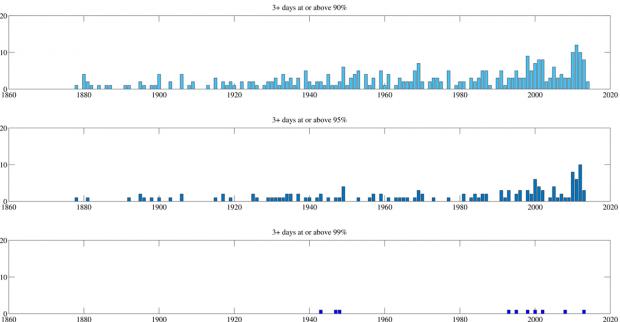
Figure 1. The number of three-plus day events that were within the top 10% warmest of minimum temperatures for each day (top), 5% warmest (middle), and 1% warmest (bottom) at Atlantic City Marina.
Most stations do not have runs of five or more nights within the top 1%. This is not surprising, as minimum temperature anomalies are not too stable over multiple days given their sensitivity to even subtle changes in air mass characteristics. Looking at other percentiles, we find that six stations saw a significant increase of five or more day events in the top 10% warmest of events, and four of those stations had a significant trend in the top 5% over their individual period of records. The trend of Belleplain-Millville, one of the three significant stations at in the top 5%, can be seen in Figure 2.
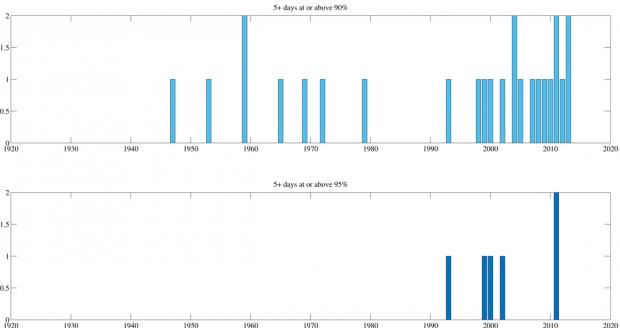
Figure 2. The number of five-plus day events that were within the top 10% warmest of minimum temperatures for each day (top) and 5% warmest (bottom) at Belleplain-Millville.
Out of all of the stations, Atlantic City, Newark Airport, and Belleplain-Millville all reported significant positive trends in all categories. The other four stations were more variable throughout the classes . This suggests the need for further research into how heat events may differ from urban areas to non-urban areas in New Jersey.
Excessive heat during the nighttime can pose a health risk for varying reasons. Since we generally associate the nighttime with cooler temperatures, people may be less aware about the stress that consecutively warm evenings can put on their body. Combining this with the lack of resources for relief and the already-present toll of daytime heat, it poses a potentially critical health issue that needs to be addressed. We are in the process of preparing a longer report that will touch on these subjects in more detail.


